light OPEL CORSA F 2020 Manual user
[x] Cancel search | Manufacturer: OPEL, Model Year: 2020, Model line: CORSA F, Model: OPEL CORSA F 2020Pages: 229, PDF Size: 21.14 MB
Page 178 of 229
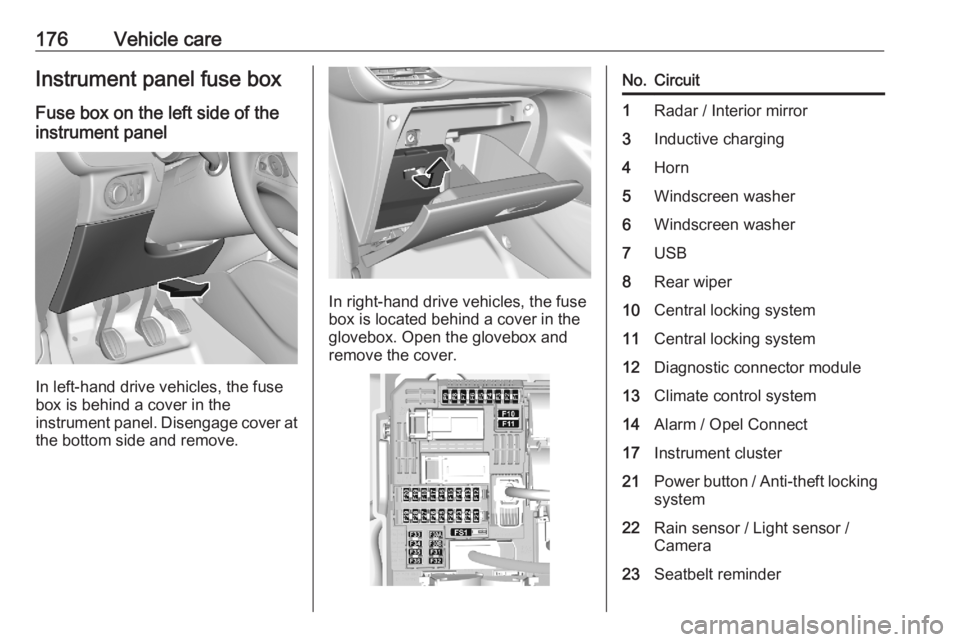
176Vehicle careInstrument panel fuse boxFuse box on the left side of the
instrument panel
In left-hand drive vehicles, the fuse
box is behind a cover in the
instrument panel. Disengage cover at
the bottom side and remove.
In right-hand drive vehicles, the fuse
box is located behind a cover in the
glovebox. Open the glovebox and
remove the cover.
No.Circuit1Radar / Interior mirror3Inductive charging4Horn5Windscreen washer6Windscreen washer7USB8Rear wiper10Central locking system11Central locking system12Diagnostic connector module13Climate control system14Alarm / Opel Connect17Instrument cluster21Power button / Anti-theft locking system22Rain sensor / Light sensor /
Camera23Seatbelt reminder
Page 179 of 229
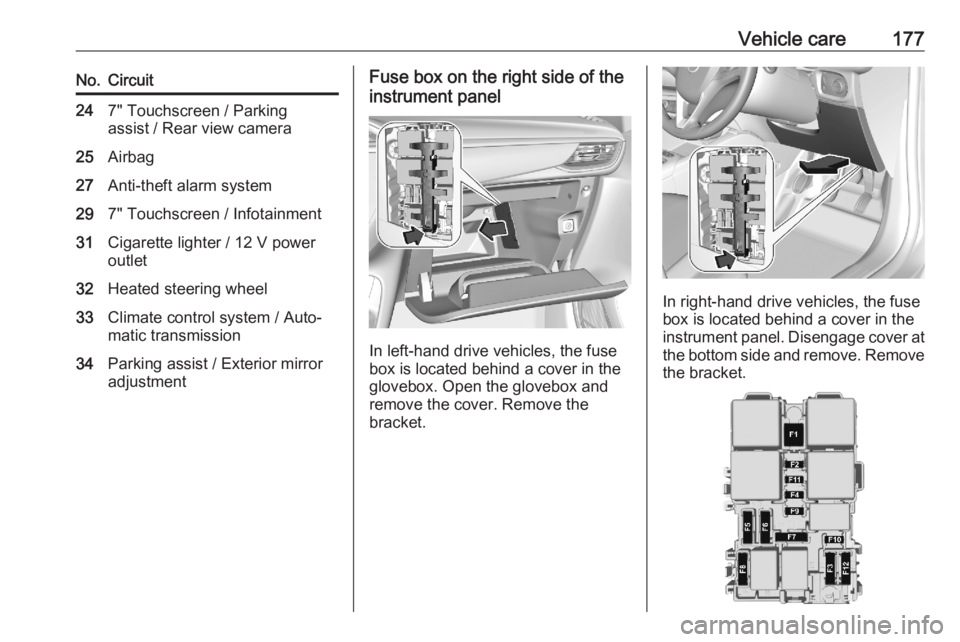
Vehicle care177No.Circuit247" Touchscreen / Parking
assist / Rear view camera25Airbag27Anti-theft alarm system297" Touchscreen / Infotainment31Cigarette lighter / 12 V power
outlet32Heated steering wheel33Climate control system / Auto‐
matic transmission34Parking assist / Exterior mirror
adjustmentFuse box on the right side of the
instrument panel
In left-hand drive vehicles, the fuse
box is located behind a cover in the
glovebox. Open the glovebox and
remove the cover. Remove the
bracket.
In right-hand drive vehicles, the fuse
box is located behind a cover in the
instrument panel. Disengage cover at
the bottom side and remove. Remove
the bracket.
Page 186 of 229
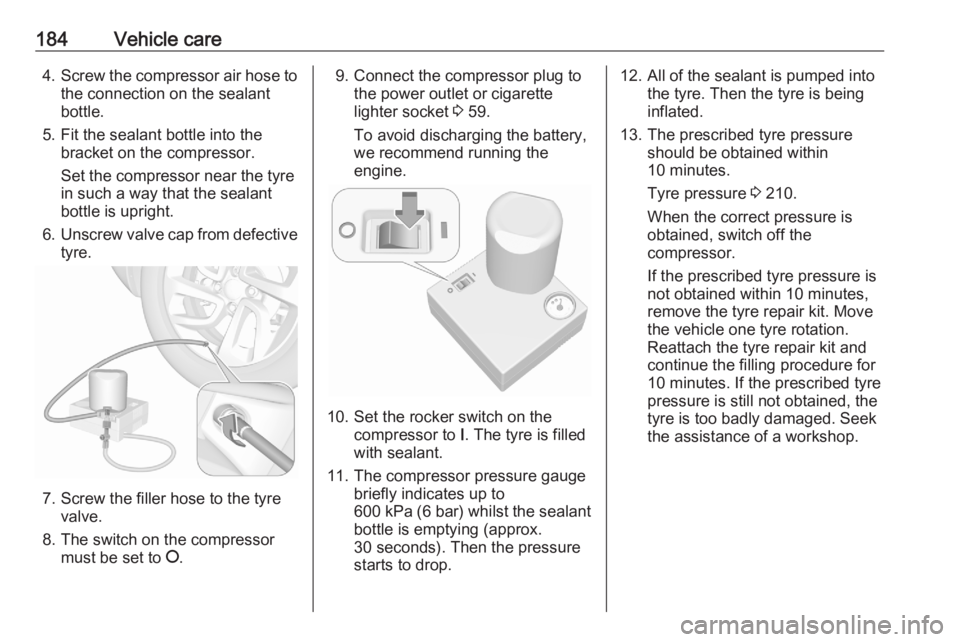
184Vehicle care4.Screw the compressor air hose to
the connection on the sealant
bottle.
5. Fit the sealant bottle into the bracket on the compressor.
Set the compressor near the tyre
in such a way that the sealant
bottle is upright.
6. Unscrew valve cap from defective
tyre.
7. Screw the filler hose to the tyre valve.
8. The switch on the compressor must be set to J.
9. Connect the compressor plug to
the power outlet or cigarette
lighter socket 3 59.
To avoid discharging the battery,
we recommend running the
engine.
10. Set the rocker switch on the compressor to I. The tyre is filled
with sealant.
11. The compressor pressure gauge briefly indicates up to
600 kPa (6 bar) whilst the sealant
bottle is emptying (approx.
30 seconds). Then the pressure
starts to drop.
12. All of the sealant is pumped into the tyre. Then the tyre is being
inflated.
13. The prescribed tyre pressure should be obtained within
10 minutes.
Tyre pressure 3 210.
When the correct pressure is
obtained, switch off the
compressor.
If the prescribed tyre pressure is
not obtained within 10 minutes,
remove the tyre repair kit. Move
the vehicle one tyre rotation.
Reattach the tyre repair kit and
continue the filling procedure for 10 minutes. If the prescribed tyre
pressure is still not obtained, the
tyre is too badly damaged. Seek
the assistance of a workshop.
Page 194 of 229

192Vehicle care3. Connect the black lead to thenegative terminal of the booster
battery.
4. Connect the other end of the black
lead to a vehicle grounding point
of your vehicle in the engine
compartment.
Route the leads so that they cannot
catch on rotating parts in the engine
compartment.
To start the engine: 1. Start the engine of the vehicle providing the jump.
2. After 5 minutes, start the other engine. Start attempts should be
made for no longer than
15 seconds at an interval of
1 minute.
3. Allow both engines to idle for approx. 3 minutes with the leads
connected.
4. Switch on the needed electrical consumers e.g. headlights,
heated rear window.
5. Reverse above sequence exactly when removing leads.Towing
Towing the vehicle
Remove the cap.
The towing eye is stowed with the
vehicle tools 3 178.
Screw in the towing eye as far as it will
go until it stops in a horizontal
position.
Attach the tow rod to the towing eye. The towing eye must only be used for
towing and not for recovering the
vehicle.
Switch on ignition to release steering
wheel lock and to permit operation of
brake lights, horn and windscreen
wiper.
Page 197 of 229
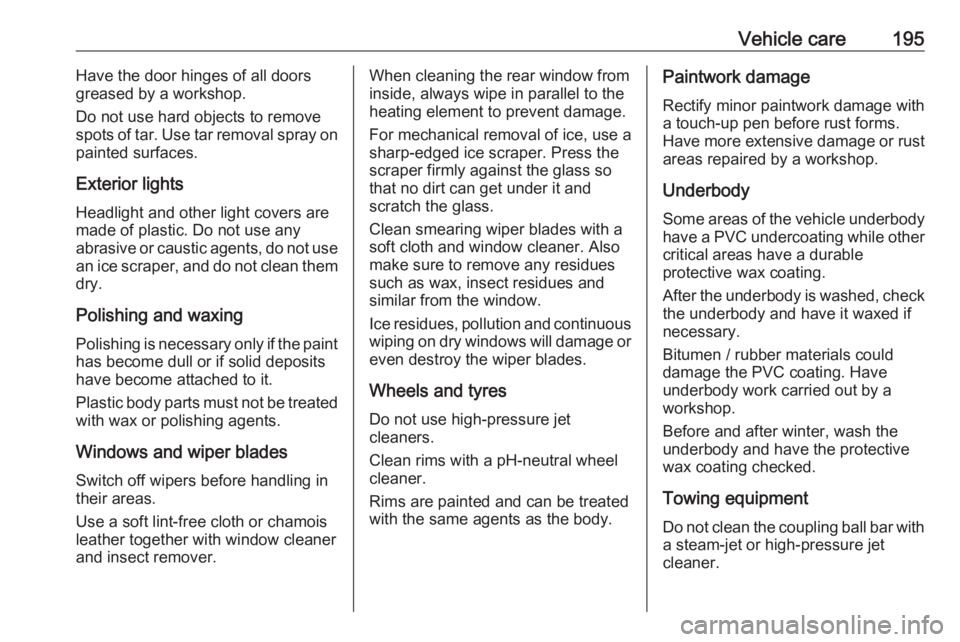
Vehicle care195Have the door hinges of all doors
greased by a workshop.
Do not use hard objects to remove
spots of tar. Use tar removal spray on
painted surfaces.
Exterior lights Headlight and other light covers are
made of plastic. Do not use any
abrasive or caustic agents, do not use
an ice scraper, and do not clean them
dry.
Polishing and waxing
Polishing is necessary only if the paint
has become dull or if solid deposits
have become attached to it.
Plastic body parts must not be treated with wax or polishing agents.
Windows and wiper blades Switch off wipers before handling in
their areas.
Use a soft lint-free cloth or chamois
leather together with window cleaner
and insect remover.When cleaning the rear window from
inside, always wipe in parallel to the
heating element to prevent damage.
For mechanical removal of ice, use a
sharp-edged ice scraper. Press the
scraper firmly against the glass so
that no dirt can get under it and
scratch the glass.
Clean smearing wiper blades with a
soft cloth and window cleaner. Also
make sure to remove any residues
such as wax, insect residues and
similar from the window.
Ice residues, pollution and continuous
wiping on dry windows will damage or even destroy the wiper blades.
Wheels and tyres
Do not use high-pressure jet
cleaners.
Clean rims with a pH-neutral wheel
cleaner.
Rims are painted and can be treated
with the same agents as the body.Paintwork damage
Rectify minor paintwork damage witha touch-up pen before rust forms.
Have more extensive damage or rust
areas repaired by a workshop.
Underbody Some areas of the vehicle underbody
have a PVC undercoating while other
critical areas have a durable
protective wax coating.
After the underbody is washed, check the underbody and have it waxed if
necessary.
Bitumen / rubber materials could damage the PVC coating. Have
underbody work carried out by a
workshop.
Before and after winter, wash the
underbody and have the protective
wax coating checked.
Towing equipment
Do not clean the coupling ball bar with
a steam-jet or high-pressure jet
cleaner.
Page 198 of 229
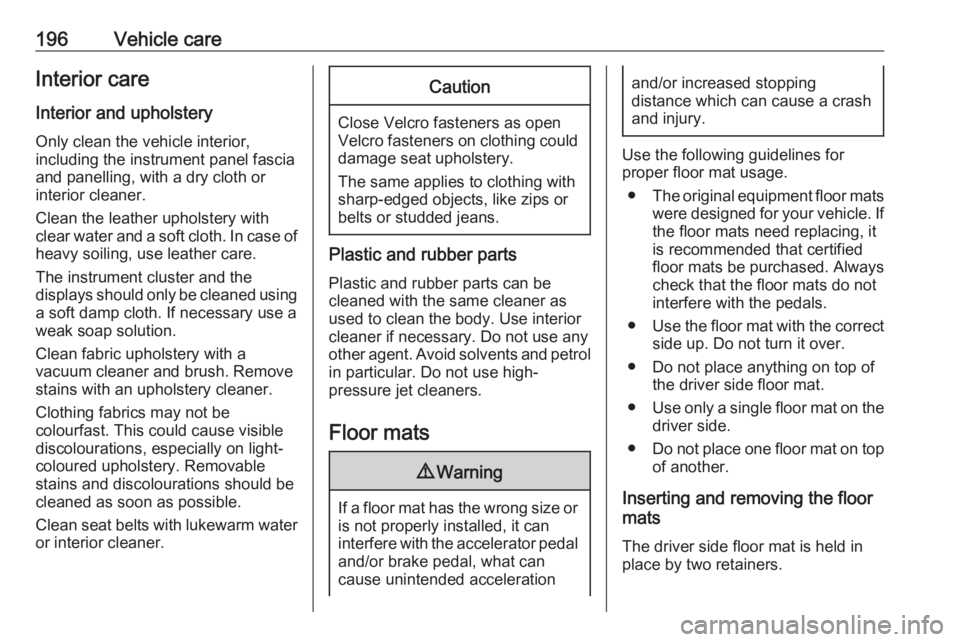
196Vehicle careInterior careInterior and upholstery
Only clean the vehicle interior,
including the instrument panel fascia
and panelling, with a dry cloth or
interior cleaner.
Clean the leather upholstery with
clear water and a soft cloth. In case of
heavy soiling, use leather care.
The instrument cluster and the
displays should only be cleaned using a soft damp cloth. If necessary use aweak soap solution.
Clean fabric upholstery with a
vacuum cleaner and brush. Remove
stains with an upholstery cleaner.
Clothing fabrics may not be
colourfast. This could cause visible
discolourations, especially on light-
coloured upholstery. Removable
stains and discolourations should be
cleaned as soon as possible.
Clean seat belts with lukewarm water or interior cleaner.Caution
Close Velcro fasteners as open
Velcro fasteners on clothing could damage seat upholstery.
The same applies to clothing with
sharp-edged objects, like zips or
belts or studded jeans.
Plastic and rubber parts
Plastic and rubber parts can be
cleaned with the same cleaner as
used to clean the body. Use interior cleaner if necessary. Do not use any
other agent. Avoid solvents and petrol in particular. Do not use high-
pressure jet cleaners.
Floor mats
9 Warning
If a floor mat has the wrong size or
is not properly installed, it can
interfere with the accelerator pedal
and/or brake pedal, what can
cause unintended acceleration
and/or increased stopping
distance which can cause a crash and injury.
Use the following guidelines for
proper floor mat usage.
● The original equipment floor mats
were designed for your vehicle. If the floor mats need replacing, it
is recommended that certified
floor mats be purchased. Always
check that the floor mats do not
interfere with the pedals.
● Use the floor mat with the correct
side up. Do not turn it over.
● Do not place anything on top of the driver side floor mat.
● Use only a single floor mat on the
driver side.
● Do not place one floor mat on top
of another.
Inserting and removing the floor
mats
The driver side floor mat is held in
place by two retainers.
Page 219 of 229

Customer information217Vehicle data recording
and privacy
Event data recorders Electronic control units are installed in
your vehicle. Control units process
data which is received by vehicle
sensors, for example, or which they
generate themselves or exchange
amongst themselves. Some control
units are necessary for the safe
functioning of your vehicle, others
assist you while you drive (driver
assistance systems), while others
provide comfort or infotainment
functions.
The following contains general
information about data processing in
the vehicle. You will find additional
information as to which specific data
is uploaded, stored and passed on to third parties and for what purpose in
your vehicle under the key word Data Protection closely linked to the
references for the affected functional
characteristics in the relevant owner's
manual or in the general terms of
sale. These are also available online.Operating data in the vehicle
Control units process data for
operation of the vehicle.
This data includes, for example: ● vehicle status information (e.g. speed, movement delay, lateral
acceleration, wheel rotation rate,
"seat belts fastened" display)
● ambient conditions (e.g. temperature, rain sensor,
distance sensor)
As a rule such data is transient and is not stored for longer than an
operational cycle, and only processed
on board the vehicle itself. Often
control units include data storage
(including the vehicle key). This is
used to allow information to be
documented temporarily or
permanently on vehicle condition,
component stress, maintenance
requirements and technical events
and errors.Depending on technical equipment
levels, the data stored is as follows:
● system component operating states (e.g. fill level, tyre
pressure, battery status)
● faults and defects in important system components (e.g. lights,
brakes)
● system reactions in special driving situations (e.g. triggeringof an airbag, actuation of the
stability control systems)
● information on events damaging the vehicle
● for electric vehicles the amount of
charge in the high-voltage
battery, estimated range
In special cases (e.g. if the vehicle
has detected a malfunction), it may be
necessary to save data that would
otherwise just be volatile.
When you use services (e.g. repairs,
maintenance), the operating data
saved can be read together with the
vehicle identification number and
used where necessary. Staff working
for the service network ( e.g. garages,
manufacturers) or third parties (e.g.
Page 220 of 229
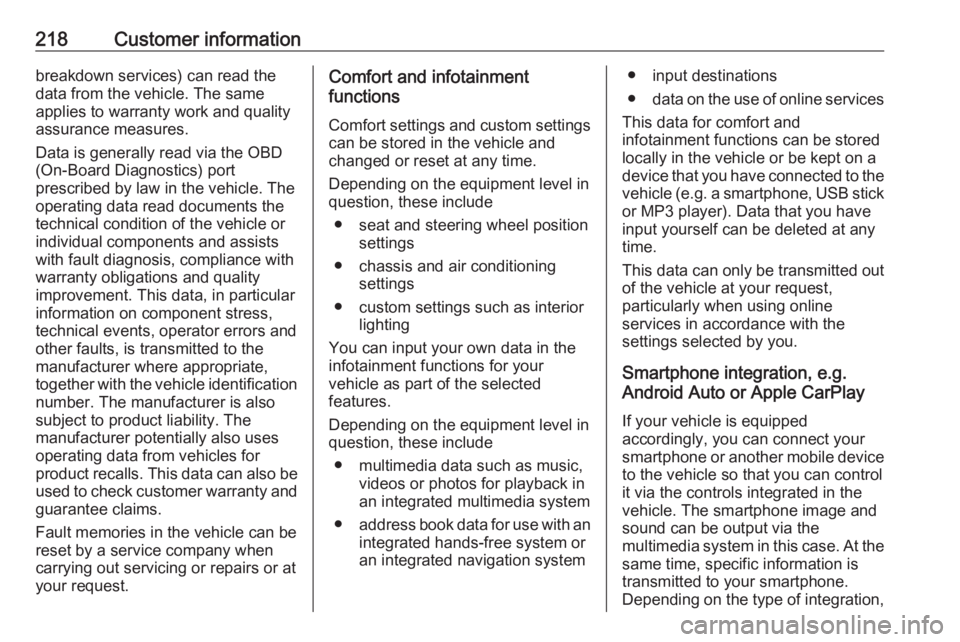
218Customer informationbreakdown services) can read the
data from the vehicle. The same
applies to warranty work and quality
assurance measures.
Data is generally read via the OBD
(On-Board Diagnostics) port
prescribed by law in the vehicle. The operating data read documents the
technical condition of the vehicle or
individual components and assists
with fault diagnosis, compliance with
warranty obligations and quality
improvement. This data, in particular
information on component stress,
technical events, operator errors and
other faults, is transmitted to the
manufacturer where appropriate,
together with the vehicle identification
number. The manufacturer is also
subject to product liability. The
manufacturer potentially also uses
operating data from vehicles for
product recalls. This data can also be used to check customer warranty and
guarantee claims.
Fault memories in the vehicle can be
reset by a service company when
carrying out servicing or repairs or at
your request.Comfort and infotainment
functions
Comfort settings and custom settings can be stored in the vehicle and
changed or reset at any time.
Depending on the equipment level in
question, these include
● seat and steering wheel position settings
● chassis and air conditioning settings
● custom settings such as interior lighting
You can input your own data in the
infotainment functions for your
vehicle as part of the selected
features.
Depending on the equipment level in
question, these include
● multimedia data such as music, videos or photos for playback in
an integrated multimedia system
● address book data for use with an
integrated hands-free system or
an integrated navigation system● input destinations
● data on the use of online services
This data for comfort and
infotainment functions can be stored
locally in the vehicle or be kept on a
device that you have connected to the
vehicle ( e.g. a smartphone, USB stick
or MP3 player). Data that you have
input yourself can be deleted at any
time.
This data can only be transmitted out
of the vehicle at your request,
particularly when using online
services in accordance with the
settings selected by you.
Smartphone integration, e.g.
Android Auto or Apple CarPlay
If your vehicle is equipped
accordingly, you can connect your
smartphone or another mobile device to the vehicle so that you can control
it via the controls integrated in the
vehicle. The smartphone image and
sound can be output via the
multimedia system in this case. At the
same time, specific information is
transmitted to your smartphone.
Depending on the type of integration,
Page 224 of 229
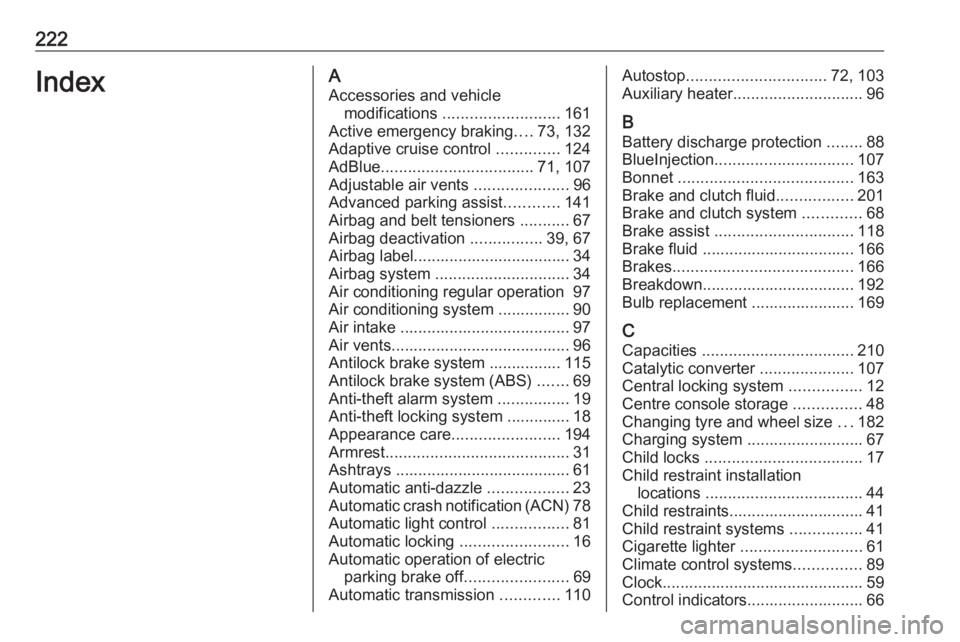
222IndexAAccessories and vehicle modifications .......................... 161
Active emergency braking ....73, 132
Adaptive cruise control ..............124
AdBlue .................................. 71, 107
Adjustable air vents .....................96
Advanced parking assist ............141
Airbag and belt tensioners ...........67
Airbag deactivation ................39, 67
Airbag label................................... 34 Airbag system .............................. 34
Air conditioning regular operation 97
Air conditioning system ................ 90
Air intake ...................................... 97
Air vents........................................ 96
Antilock brake system ................ 115
Antilock brake system (ABS) .......69
Anti-theft alarm system ................19
Anti-theft locking system .............. 18
Appearance care ........................194
Armrest ......................................... 31
Ashtrays ....................................... 61 Automatic anti-dazzle ..................23
Automatic crash notification (ACN) 78
Automatic light control .................81
Automatic locking ........................16
Automatic operation of electric parking brake off .......................69
Automatic transmission .............110Autostop............................... 72, 103
Auxiliary heater ............................. 96
B Battery discharge protection ........88
BlueInjection ............................... 107
Bonnet ....................................... 163
Brake and clutch fluid .................201
Brake and clutch system .............68
Brake assist ............................... 118
Brake fluid .................................. 166
Brakes ........................................ 166
Breakdown.................................. 192
Bulb replacement ....................... 169
C Capacities .................................. 210
Catalytic converter .....................107
Central locking system ................12
Centre console storage ...............48
Changing tyre and wheel size ...182
Charging system .......................... 67
Child locks ................................... 17
Child restraint installation locations ................................... 44
Child restraints.............................. 41
Child restraint systems ................41
Cigarette lighter ........................... 61
Climate control systems ...............89
Clock............................................. 59
Control indicators.......................... 66
Page 225 of 229
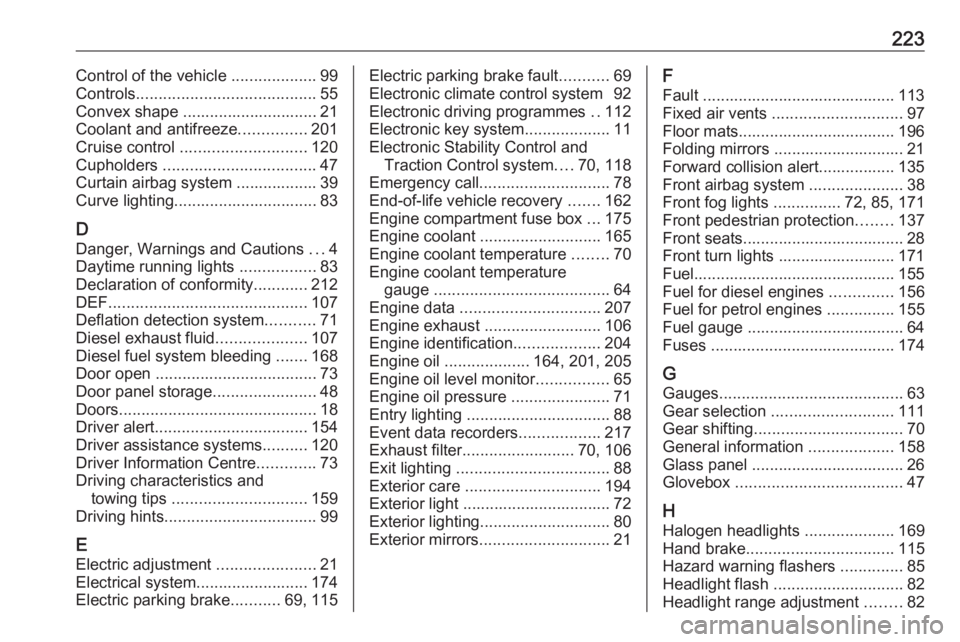
223Control of the vehicle ...................99
Controls ........................................ 55
Convex shape .............................. 21
Coolant and antifreeze ...............201
Cruise control ............................ 120
Cupholders .................................. 47
Curtain airbag system .................. 39
Curve lighting................................ 83
D Danger, Warnings and Cautions ...4
Daytime running lights .................83
Declaration of conformity ............212
DEF ............................................ 107
Deflation detection system ...........71
Diesel exhaust fluid ....................107
Diesel fuel system bleeding .......168
Door open .................................... 73
Door panel storage .......................48
Doors ............................................ 18
Driver alert .................................. 154
Driver assistance systems ..........120
Driver Information Centre .............73
Driving characteristics and towing tips .............................. 159
Driving hints .................................. 99
E
Electric adjustment ......................21
Electrical system......................... 174
Electric parking brake ...........69, 115Electric parking brake fault ...........69
Electronic climate control system 92
Electronic driving programmes ..112
Electronic key system ...................11
Electronic Stability Control and Traction Control system ....70, 118
Emergency call ............................. 78
End-of-life vehicle recovery .......162
Engine compartment fuse box ...175
Engine coolant ........................... 165
Engine coolant temperature ........70
Engine coolant temperature gauge ....................................... 64
Engine data ............................... 207
Engine exhaust .......................... 106
Engine identification ...................204
Engine oil ................... 164, 201, 205
Engine oil level monitor ................65
Engine oil pressure ......................71
Entry lighting ................................ 88
Event data recorders ..................217
Exhaust filter ......................... 70, 106
Exit lighting .................................. 88
Exterior care .............................. 194
Exterior light ................................. 72
Exterior lighting ............................. 80
Exterior mirrors ............................. 21F
Fault ........................................... 113
Fixed air vents ............................. 97
Floor mats................................... 196
Folding mirrors ............................. 21
Forward collision alert................. 135
Front airbag system .....................38
Front fog lights ...............72, 85, 171
Front pedestrian protection ........137
Front seats.................................... 28
Front turn lights .......................... 171
Fuel............................................. 155
Fuel for diesel engines ..............156
Fuel for petrol engines ...............155
Fuel gauge ................................... 64
Fuses ......................................... 174
G Gauges ......................................... 63
Gear selection ........................... 111
Gear shifting ................................. 70
General information ...................158
Glass panel .................................. 26 Glovebox ..................................... 47
H Halogen headlights ....................169
Hand brake ................................. 115
Hazard warning flashers ..............85
Headlight flash ............................. 82
Headlight range adjustment ........82